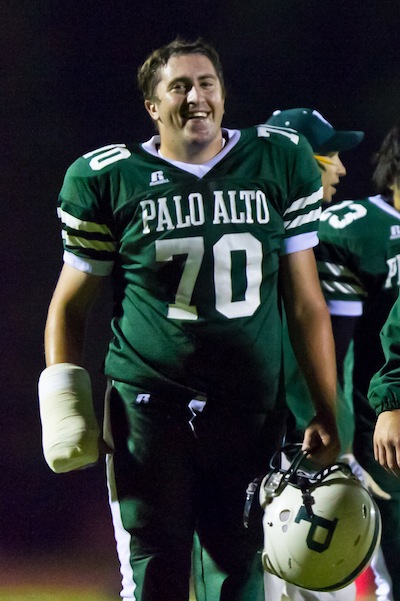“Man up. Come on, the team needs you! Push through the pain! Don’t wimp out! Shake it off!” This is not uncommon language for high school athletes to hear during a game or practice. But when is enough, enough? At what point is an injury enough to prevent athlete from playing their game?
High schools including Palo Alto High School have trained faculty to keep players from making bad choices regaurding playing through injuries.
“There are a lot of reasons why players play through injuries,” head trainer Stacey Kofman said, “We [the athletic trainers] try to determine if it would benefit the athlete to continue to play or whether it’s more detrimental to their health.”
The head trainer’s attitude however, is not necessarily shared by athletes;
“50 percent of an injury is mental and 50 percent physical.” Linebacker, Brennan Miller (’12) said, “Personally, I don’t have a problem with the pain, for me the injury inhibits me. I can’t cut as well and can’t run as fast.”
The debilitating aspect of an injury may seem obvious, but the mental effect of the injury also proposes a dilemma for an athlete. Players commonly enter a game with well-padded arm or taped hands to protect broken fingers. In order to play well, an athlete has to put minor injuries and pain aside to concentrate on doing their job well.
One reason athletes push themselves through injuries is to avoid loosing their positions. Team unity affects player’s attitudes toward playing through the pain. Players do not want to let their team down. If a player takes a break because of an injury he or she could be replaced by another player who could shine at the position and possibly take over.
Athletes are also influenced by pressure from the team, the coaches, friends and fans.
“I work harder in the weight room to get stronger to keep my position on the field” Linebacker Erik Anderson (‘13) said.
Players feel a responsibility and drive to do their best, injury or not in order to not let these people down.
Due to these reasons, an athlete may feel compelled to go back into the game, but a trainer must step in and assess seriousness of the injury. Injuries, such as sprains, can seem minor at first, but could develop into an injury that requires surgery and months of healing and rehab.
“We have players who play with first and second degree sprains all the time, but we do the rehab to get them back to the game safely,” Kofman said.
Along side Kofman, trainer Josh Goldstein, has to be alert in order to spot players who may not want to be pulled from the game to prevent worsening an injury.
“If I see somebody favoring a body part,” Goldstein said, “you can tell they are not using a body part properly, [and] I pull them aside and say ‘hey are you doing ok?’”
For trainers, taking a key player out of a close game is not an easy call. The trainer acts as the gatekeeper, preventing athletes from serious injuries.
Bone fractures can also lead to growth plate damages, which could affect an athlete’s final height and bone density. These fractures can potentially cause long-term pain that an athlete may have to endure for life. Athletes who want to play in every game are only thinking of this play, this game, this season.
“If it [the injury] is at the growth plate, we certainly want to wait,” Kofman said, “we don’t want to impede somebody’s growth factor. Sometimes players make attempts to play through a sprained ankle or a broken thumb because of their love for the game. Injuries can impede an athletes’ ability to perform, and game-changing plays can expose an injury.”
So, is it really worth it for an athlete to go back in the game and perhaps cause an injury to become a long-term injury? Athletes must live with these bodies for the rest of their lives, is it really worth it to cause long-term pain and complications from an injury to their bodies by playing rough and physically demanding sports? Will that one game against the cross-town rival really matter that much in 25 years?
For some, it is worth the extra effort because they want to play sports at a higher level and athletics can be the ticket to college with scholarships. Many professional athletes would not be where they are today if they did not play through their injuries. Former NFL quarterback Steve Young believes that playing through injuries can lead to greater consequences.
“I didn’t mind playing through injuries that were not debilitating or long term,” Young said, “Anything that could be [debilitating or long term], you better rest up, you may lose your job, but at least you don’t lose your health.”
Young contends serious secondary injuries may result when a player continues to play with a severe initial injury.
“I think you really get hurt when you are confused or overwhelmed, so preparation is a big part of staying healthy,” Young said.
Athletes have to know before entering a sport that they have to protect their bodies. They have to be responsible for their own safety. For athletes in all sports the trainer has the last word about whether or not a team member takes the field.
“It is up to the trainers to determine whether or not the injury is severe or not severe enough for them to come out,” Goldstein said.
Training for a sport can help decrease the risk of an injury.
“Strength training, speed training, knowing proper technique of your position,” Goldstein said.
Man Up? Push through the pain?
May not be such a hot idea. It’s a short-term solution for a potentially long-term problem.




